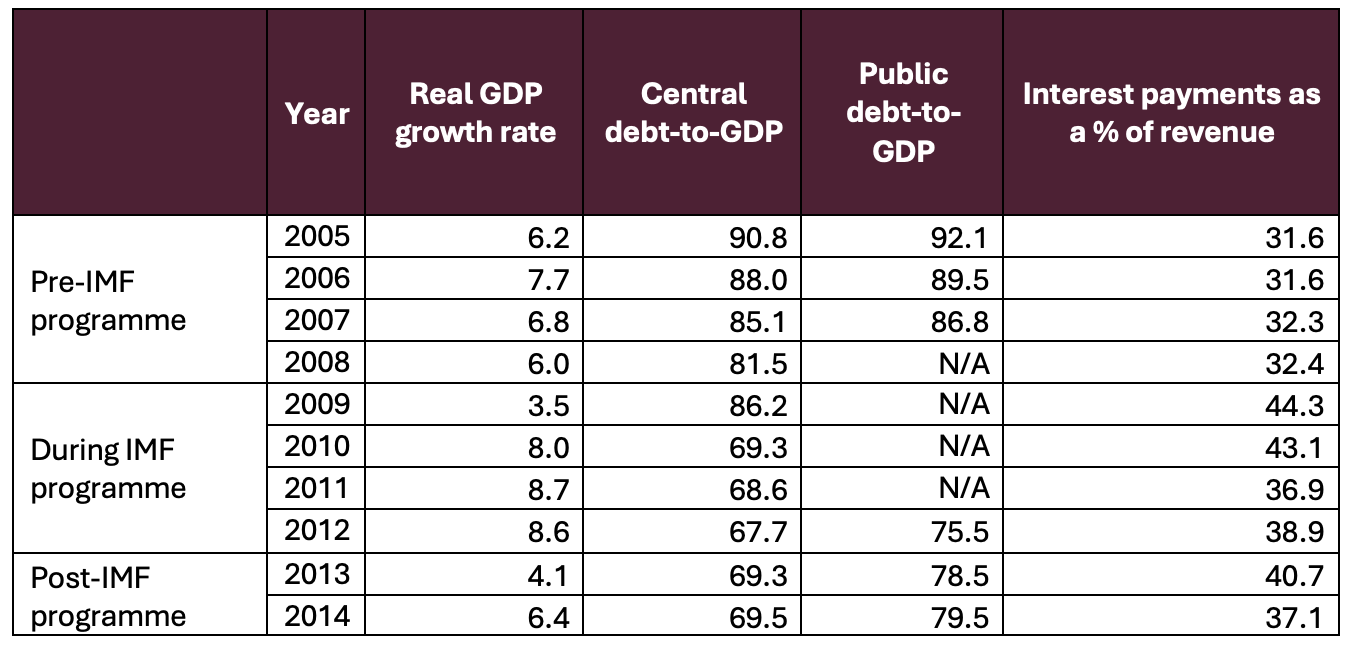Fact Check
MP Rajapaksa claims that during his tenure as president (2005-2014), there was an (1) unbroken nine-year economic boom, and (2) there was no difficulty in paying off debts.
To verify these claims, FactCheck.lk consulted data from the Central Bank of Sri Lanka (CBSL) and Ministry of Finance annual reports, IMF world economic outlook 2024 and IMF staff report 2009.
Claim (1): An ‘economic boom’ might be understood broadly as a consistent period of growth that significantly exceeds the average growth of the previous period. From 1995-2004, Sri Lanka’s average GDP growth rate was 5.1%. The average GDP growth rate from 2005-2014 was 6.6%. This significant increase in the average growth rate supports the claim of an ‘economic boom’ from 2005-2014 (see Additional Note 1).
Claim (2): This claim cannot be supported, due to two reasons.
First, the IMF staff report 2009 noted that Sri Lanka’s debt situation was “unsustainable…in the absence of corrective steps.” Subsequently, Sri Lanka entered a Stand-By Agreement (SBA) with the IMF in 2009, indicating that the country faced difficulties in managing its debt (see Additional Note 2). The staff report and SBA are evidence of ‘difficulties’ in managing debt during the MP’s tenure as president.
Second, economists tend to identify the reducing of difficulty in paying debt as a consistent decline or stability in at least two economic indicators: (i) the interest cost-to-revenue ratio (reflects debt service pressure on the budget), and (ii) the debt-to-GDP ratio (indicates debt burden of the country).
Exhibit 1 and Additional Notes 3 and 4 explain how these indicators don’t support the claim either. Broadly, debt pressures on one or both indicators increased pre-IMF programme, stabilised or declined during, and increased again after its conclusion.
The volatility in the above indicators, and Sri Lanka’s need to enter an IMF arrangement in 2009, undermine the claim about ease of repaying debt.
In sum, the data supports the MP’s characterisation of the 2005-2014 period as a time of economic boom; but does not support the claim of having “no difficulties” in servicing debt.
Therefore, we classify the MP’s claim as PARTLY TRUE.
Additional note 1: Exhibit 1 shows that within the period of consideration the real GDP growth rate fell below the historical average in 2009 and 2013. Since these are only two exceptions in a 10-year period with a high average, and none of these blips were negative growth, we take them as not discrediting the claim of an ‘unbroken’ economic boom.
Additional note 2: The Stand-by Arrangement (SBA) provides short-term financial assistance to countries facing balance of payments problems that typically arise from negative trade balances and debt repayment pressures.
Additional Note 3: Exhibit 1 shows that the interest-to-revenue ratio increased steadily from 2005-2008, peaking at 44.3% in 2009. During the IMF programme, the ratio declined from 2009-2011 but rose again in 2012. It increased from 2012-2013 before dropping to 37.1% in 2014.
Additional Note 4: Exhibit 1 shows that the Public Debt-to-GDP (PD-to-GDP) ratio decreased from 2005-2007, before the IMF programme, but started to climb again from 2012-2014, in the post-IMF period. In the absence of PD-to-GDP ratio from 2008-2011, this fact-check used Central Debt-to-GDP (CD-to-GDP) figures for this period. This ratio increased by 4.7 percentage points from 2008-2009. From 2009-2012, the ratio consistently declined during the IMF programme but began to rise again from 2013-2014, post-IMF.
Despite the lack of consistent data, the PD-to-GDP figures have been referred to as, it is a more accurate depiction of a country’s debt burden compared to CD-to-GDP figures. Previous fact-checks have highlighted this distinction (see https://factcheck.lk/factcheck/mp-rajapaksa-misrepresents-past-reduction-of-debt-burden).
Exhibit 1: Macroeconomic indicators (2005 – 2014)

Sources
Central Bank of Sri Lanka, Annual Reports, available at, https://www.cbsl.gov.lk/en/publications/economic-and-financial-reports/annual-reports.
Ministry of Finance, Annual Report 2014, available at, https://www.treasury.gov.lk/api/file/33f4533e-3106-4496-86b3-73f696652e05.
International Monetary Fund, ‘IMF Country Report No. 09/310, Sri Lanka’, November 2009, available at: https://www.imf.org/external/pubs/ft/scr/2009/cr09310.pdf
International Monetary Fund, World Economic Outlook database 2024, available at : https://www.imf.org/external/datamapper/NGDP_RPCH@WEO/OEMDC/ADVEC/WEOWORLD


